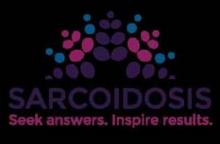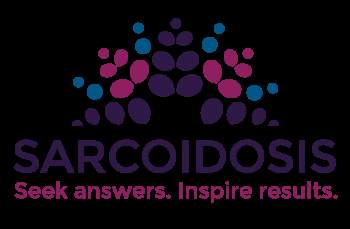User login
In honor of National Sarcoidosis Awareness month, the CHEST Foundation and Foundation for Sarcoidosis Research (FSR) have launched Sarcoidosis: Seek Answers. Inspire Results., a nationwide campaign encouraging patients with sarcoidosis to take a proactive role in their treatment plan (www.stopsarcoidosis.org/patient-resources/what-is-sarcoidosis).
This rare, autoimmune disease, which affects the lungs in 90% of cases, can often mimic other conditions as well, further adding to the complexity of the disorder. For instance, sarcoidosis can mimic fungal or mycobacterial infections, chronic beryllium disease, hypersensitivity pneumonitis, rheumatologic syndromes, lymphoma, tumor-associated granulomas, pulmonary fibrosis, and more. Lung symptoms often include a cough that does not go away, shortness of breath, and chest pain. About one-third of patients will also experience nonspecific symptoms, such as fever, fatigue, weight loss, night sweats, and an overall feeling of ill health. Key diagnostic tools include chest radiographs, laboratory blood tests, breathing tests, and a biopsy.
Anyone can develop sarcoidosis; however, for reasons not yet understood by medical science, the condition is more prevalent among African-Americans and people of Northern European – particularly Scandinavian – descent. Sarcoidosis most commonly occurs among people between the ages of 20 and 40.
If diagnosed and under good medical care, most cases of sarcoidosis have a positive prognosis and do not cause lasting damage to the body. However, 30% to 40% of people living with sarcoidosis have a persistent condition that may require personalized treatment – including co-consultation with other organ specialists, as indicated – to control symptoms.
To this end, the Seek Answers. Inspire Results. campaign encourages physician/patient dialogue, as well as treatment compliance. For educational tools to share with patients, including the “Sarcoid Five” – five questions designed to jumpstart physician/patient conversations – visit chestnet.org/sarcoid.
Patient education resources supported in part by a grant from Mallinckrodt Pharmaceuticals Autoimmune and Rare Diseases.
For further reading:
www.stopsarcoidosis.org/patient-resources/what-is-sarcoidosis/
In honor of National Sarcoidosis Awareness month, the CHEST Foundation and Foundation for Sarcoidosis Research (FSR) have launched Sarcoidosis: Seek Answers. Inspire Results., a nationwide campaign encouraging patients with sarcoidosis to take a proactive role in their treatment plan (www.stopsarcoidosis.org/patient-resources/what-is-sarcoidosis).
This rare, autoimmune disease, which affects the lungs in 90% of cases, can often mimic other conditions as well, further adding to the complexity of the disorder. For instance, sarcoidosis can mimic fungal or mycobacterial infections, chronic beryllium disease, hypersensitivity pneumonitis, rheumatologic syndromes, lymphoma, tumor-associated granulomas, pulmonary fibrosis, and more. Lung symptoms often include a cough that does not go away, shortness of breath, and chest pain. About one-third of patients will also experience nonspecific symptoms, such as fever, fatigue, weight loss, night sweats, and an overall feeling of ill health. Key diagnostic tools include chest radiographs, laboratory blood tests, breathing tests, and a biopsy.
Anyone can develop sarcoidosis; however, for reasons not yet understood by medical science, the condition is more prevalent among African-Americans and people of Northern European – particularly Scandinavian – descent. Sarcoidosis most commonly occurs among people between the ages of 20 and 40.
If diagnosed and under good medical care, most cases of sarcoidosis have a positive prognosis and do not cause lasting damage to the body. However, 30% to 40% of people living with sarcoidosis have a persistent condition that may require personalized treatment – including co-consultation with other organ specialists, as indicated – to control symptoms.
To this end, the Seek Answers. Inspire Results. campaign encourages physician/patient dialogue, as well as treatment compliance. For educational tools to share with patients, including the “Sarcoid Five” – five questions designed to jumpstart physician/patient conversations – visit chestnet.org/sarcoid.
Patient education resources supported in part by a grant from Mallinckrodt Pharmaceuticals Autoimmune and Rare Diseases.
For further reading:
www.stopsarcoidosis.org/patient-resources/what-is-sarcoidosis/
In honor of National Sarcoidosis Awareness month, the CHEST Foundation and Foundation for Sarcoidosis Research (FSR) have launched Sarcoidosis: Seek Answers. Inspire Results., a nationwide campaign encouraging patients with sarcoidosis to take a proactive role in their treatment plan (www.stopsarcoidosis.org/patient-resources/what-is-sarcoidosis).
This rare, autoimmune disease, which affects the lungs in 90% of cases, can often mimic other conditions as well, further adding to the complexity of the disorder. For instance, sarcoidosis can mimic fungal or mycobacterial infections, chronic beryllium disease, hypersensitivity pneumonitis, rheumatologic syndromes, lymphoma, tumor-associated granulomas, pulmonary fibrosis, and more. Lung symptoms often include a cough that does not go away, shortness of breath, and chest pain. About one-third of patients will also experience nonspecific symptoms, such as fever, fatigue, weight loss, night sweats, and an overall feeling of ill health. Key diagnostic tools include chest radiographs, laboratory blood tests, breathing tests, and a biopsy.
Anyone can develop sarcoidosis; however, for reasons not yet understood by medical science, the condition is more prevalent among African-Americans and people of Northern European – particularly Scandinavian – descent. Sarcoidosis most commonly occurs among people between the ages of 20 and 40.
If diagnosed and under good medical care, most cases of sarcoidosis have a positive prognosis and do not cause lasting damage to the body. However, 30% to 40% of people living with sarcoidosis have a persistent condition that may require personalized treatment – including co-consultation with other organ specialists, as indicated – to control symptoms.
To this end, the Seek Answers. Inspire Results. campaign encourages physician/patient dialogue, as well as treatment compliance. For educational tools to share with patients, including the “Sarcoid Five” – five questions designed to jumpstart physician/patient conversations – visit chestnet.org/sarcoid.
Patient education resources supported in part by a grant from Mallinckrodt Pharmaceuticals Autoimmune and Rare Diseases.
For further reading:
www.stopsarcoidosis.org/patient-resources/what-is-sarcoidosis/

